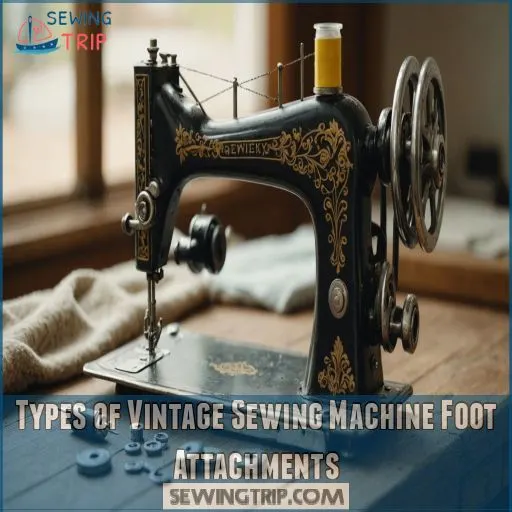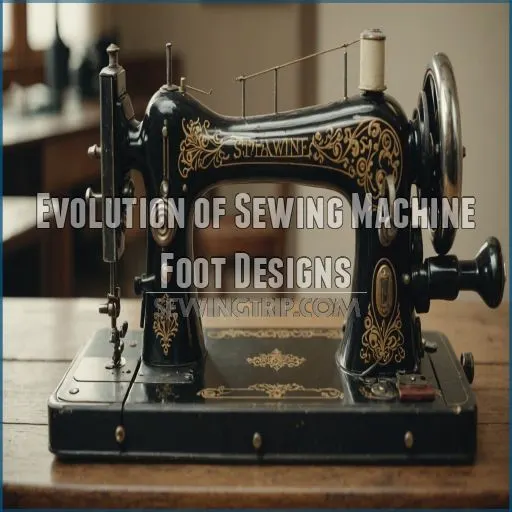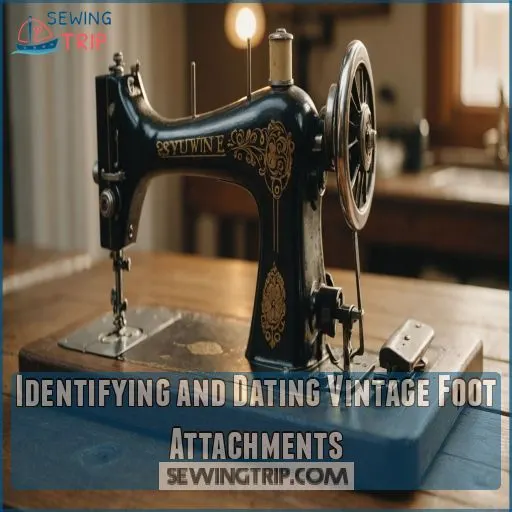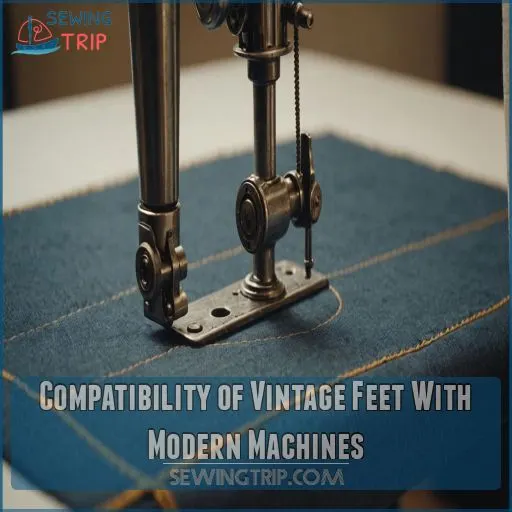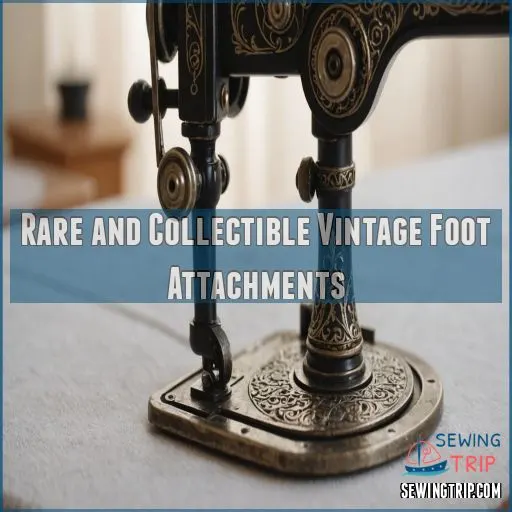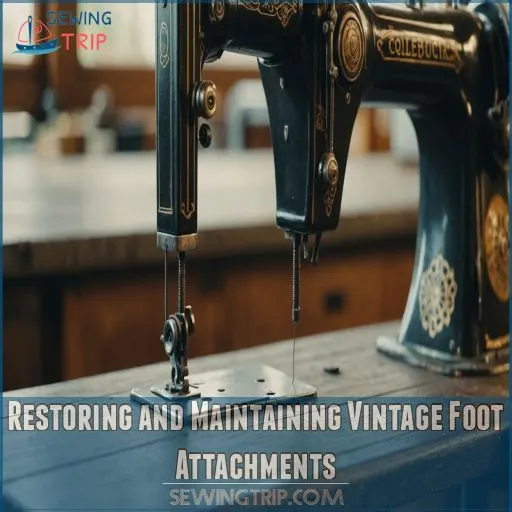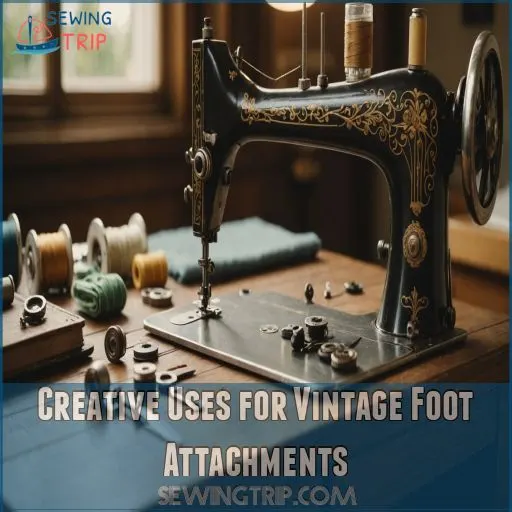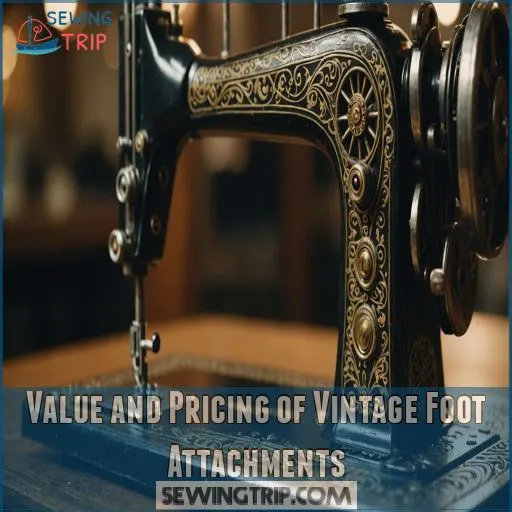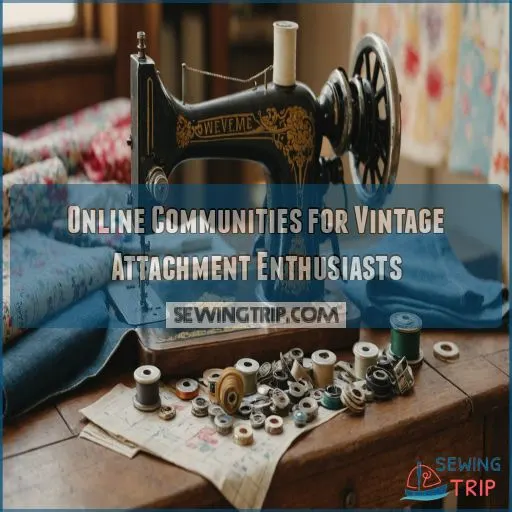This site is supported by our readers. We may earn a commission, at no cost to you, if you purchase through links.
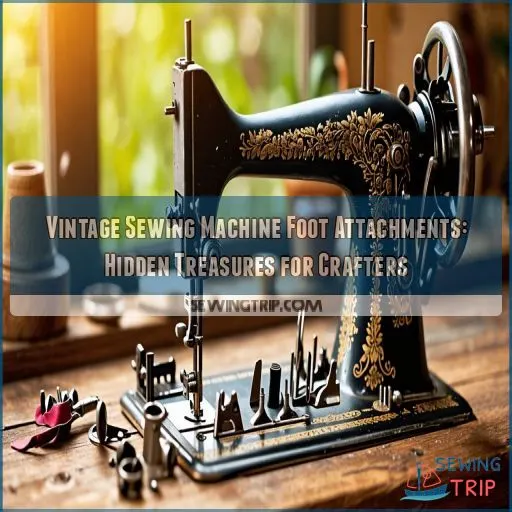
You’ve got the basics like hemmers and edge stitchers, while rarities like the zigzag attachment hint at hidden sewing secrets.
Compatibility is key, so understanding shank types and adapters is important if you want to mix old and new.
Whether you’re jazzing up modern projects or indulging in pure nostalgia, these attachments offer endless creative possibilities.
Fascinated by their intricate designs? There’s plenty more to uncover about their history and unique applications, including the vintage sewing machine.
Table Of Contents
- Key Takeaways
- Types of Vintage Sewing Machine Foot Attachments
- Evolution of Sewing Machine Foot Designs
- Identifying and Dating Vintage Foot Attachments
- Compatibility of Vintage Feet With Modern Machines
- Rare and Collectible Vintage Foot Attachments
- Restoring and Maintaining Vintage Foot Attachments
- Creative Uses for Vintage Foot Attachments
- Value and Pricing of Vintage Foot Attachments
- Online Communities for Vintage Attachment Enthusiasts
- Frequently Asked Questions (FAQs)
- Conclusion
Key Takeaways
- You’re diving into a world of creativity and history with vintage sewing machine foot attachments that can jazz up modern projects and indulge your nostalgia.
- Understanding shank types and compatibility is crucial for integrating vintage feet with modern machines, allowing seamless creativity.
- These attachments aren’t just collectibles; they offer practical enhancements to your sewing skills, letting you explore new techniques and styles.
- Restoration and maintenance are essential to preserve the functionality and beauty of these tools, ensuring they’re ready for your next creative adventure.
Types of Vintage Sewing Machine Foot Attachments
You’ll find a treasure trove of vintage sewing machine foot attachments, from common basics to specialized fashion aids.
These hidden gems include embroidery accessories and mechanical attachments that can transform your sewing projects, including specialized fashion aids.
Common Basic Attachments
In your vintage sewing treasure chest, you’ll find a handful of common basic attachments that’ll make your stitching a breeze.
The original presser foot is your trusty sidekick, while the adjustable hemmer and bias binder are like secret weapons for neat edges (Source).
Don’t forget the edge stitcher and narrow hemmer – they’re your go-to guys for professional-looking seams.
And when you’re feeling fancy, the ruffler and shirring foot will add some flair to your creations.
Specialty Fashion Aid Attachments
Moving beyond basic attachments, you’ll find a treasure trove of specialty fashion aid attachments. These hidden gems can transform your vintage sewing machine into a fashion powerhouse.
Let’s explore some must-have accessories:
- Edge stitcher for crisp, professional finishes
- Bias gauge for perfect bias tape application
- Blind stitch foot for invisible hems
- Gathering feet for effortless ruffles
- Buttonhole feet for flawless button closures
These attachments will have you sewing like a pro in no time!
Embroidery and Darning Accessories
Embroidery and darning accessories are the unsung heroes of vintage sewing machines. You’ll find these little gems tucked away in old sewing boxes, ready to breathe new life into your projects.
Let’s explore some popular attachments:
| Attachment | Function |
|---|---|
| Darning foot | Mends holes in fabric |
| Embroidery hoop | Holds fabric taut |
| Feed cover plate | Allows free-motion stitching |
| Stocking darner | Repairs knit items |
These attachments can turn your vintage machine into a versatile crafting powerhouse, opening up a world of creative possibilities.
Mechanical Fashion Aid Attachments
Mechanical fashion aid attachments are like a time machine for your sewing projects.
You’ll find gems like the buttonholer, a real game-changer in its day. These nifty gadgets come in various designs, from original models to cam-based versions that’ll make your buttonholes pop.
Don’t forget the walking foot – it’s your ticket to perfectly matched patterns and smooth sailing through tricky fabrics.
Evolution of Sewing Machine Foot Designs
Every stitch tells a tale of innovation in sewing machine feet. You’ve seen these little gadgets evolve from simple attachments to engineering marvels. Early foot types, like those on Thomas Saint’s 1790 design, were basic yet revolutionary.
As you tinker with your machine, you’re part of a rich history of foot design trends. Material innovation has been a game-changer, from sturdy metal to lightweight plastics.
Zipper feet, overedge feet, and binder feet each brought new possibilities to your craft. Button feet? They’re like tiny magicians, making tedious tasks a breeze. The functional impact of each new design has been huge, letting you tackle projects that once seemed impossible.
And let’s not forget design aesthetics – today’s feet aren’t just workhorses, they’re sleek and stylish too. It’s like having a Swiss Army knife for your fabric!
Identifying and Dating Vintage Foot Attachments
You’ve got a fascinating task ahead as you explore vintage sewing machine foot attachments.
Starting with identifying them through manufacturer markings and part numbers.
By examining the material and construction, and considering their compatibility with various machine models.
You’ll piece together their rich history and functionality.
Manufacturer Markings and Part Numbers
Decoding markings and part numbers helps you identify and date vintage foot attachments. Here’s how to master this:
- Check the shank type—low, high, or slant.
- Scan for part numbers like 36583 or 121441.
- Spot cover plates and needle threaders for clues.
- Beware of fakes! Historical significance matters.
Now, you’re on the path to find rare parts!
Material and Construction Clues
Two vintage sewing machine foot attachments may have subtle clues to their age and origin.
Look for metal, plastic, or wood construction, as well as stamped or engraved manufacturer markings.
The finish and sheen can also provide hints – older attachments often have a more worn, matte appearance.
Accessory storage boxes, shank adaptors, and miscellaneous items can further reveal the attachment’s history.
Compatibility With Machine Models
Those oil cans you cherish might illustrate the era of your machine, shedding light on foot compatibility.
Shank types and needle positions go hand in hand with understanding your machine’s lineage.
Utilize adapters and ankles for modern union.
Identifying Simanco numbers or examining manufacturer markings can reveal mysteries of vintage attachments’ compatibility with distinct models, ensuring seamless creativity .
Compatibility of Vintage Feet With Modern Machines
You might think vintage sewing feet are relics of the past, but with the right knowledge about shank types, adapters, and needle positions, you can use them on your modern machine.
Don’t worry—pairing these charming pieces with today’s technology is easier than handling a surprise patchwork project.
Shank Types and Sizes
After you’ve pinpointed vintage foot attachment origins, explore shank types and sizes.
Understanding shank compatibility is key—most machines feature low or high shank, impacting foot function.
Measure from the machine bed to the screw hole to determine this.
Shank type history reveals that varying designs influence compatibility, so consult shank sizing charts for precision and mastery.
Adapters and Ankles for Cross-Compatibility
Vintage sewing can be like threading a needle in the dark, but adapters and ankle types make it easier. With the right fit, you can enhance modern machine compatibility.
Consider knowing your machine’s shank types and compatibility, as low shank machines are common, but generic feet may not be compatible, requiring adapters and potentially causing damage.
- Shank sizes: Know your machine’s type.
- Finding adapters: Snap-on vs. screw-on options.
- Foot modifications: Custom solutions abound.
- Ankle strength: Durability matters.
- Gadget anticipation: Always double-check compatibility.
Needle Position Considerations
When working with vintage feet on modern machines, needle position is key.
Each foot’s compatibility depends on shank types and whether your machine’s needle can avoid striking the foot.
Era variations affect needle positions—front-back axis differences can be tricky.
Always check before sewing; it’s like ensuring you’re on the right track before hitting the gas.
Rare and Collectible Vintage Foot Attachments
Uncover a world of sewing history with rare and collectible vintage foot attachments, including limited edition designs, discontinued models, and regional variations that add value and flair to any sewing room.
You’ll appreciate how these unique pieces enhance your collection but also offer a practical glimpse into the evolution of sewing technology, bringing a touch of nostalgia to your creative projects.
Limited Edition Designs
Uncover the hidden gems of vintage sewing – limited edition foot attachments! These rare finds boast stunning designs, often created through exclusive collaborations.
Discover the design history and market value of these collectibles.
Prized for their:
- Unique Aesthetics
- Exceptional Craftsmanship
- Increased Rarity
- Enhanced Sewing Capabilities
Discontinued Models
Limited edition designs make you cherish the rarity of a sewing attachment. But you’ll also be charmed by discontinued models.
These treasures reveal hidden stories, adding value and historical richness to your collection.
Explore distinctive pieces like the Zigzag Attachment Swiss 5-Disk or Single Thread Embroidery Foot.
| Model | Rarity | Value |
|---|---|---|
| Swiss 5-Disk | High | $$$ |
| Embroidery Foot | Medium | $$ |
| Singercraft Fagoter | Unique | $$$$ |
Regional Variations
Explore the fascinating world of regional variations in vintage sewing machine foot attachments. You’ll find foot designs that reflect local needs and quirks.
Look for:
- Regional naming: Names like "Scandinavian Hemmer."
- Regional function: Custom features for unique fabrics.
- Regional marking: Distinctive stamps or insignias.
- Regional availability: Hard-to-find treasures in specific areas.
These gems reveal sewing secrets of the past.
Restoring and Maintaining Vintage Foot Attachments
Restoring and maintaining vintage foot attachments can seem intimidating, but with the right cleaning and lubrication techniques, you’ll keep them running smoothly for years.
Repair damaged components with care and source replacement parts to make sure your vintage collection remains a functional treasure trove.
Cleaning and Lubrication Techniques
After exploring rare attachments, let’s focus on making them shine again.
Use sewing machine oil and a soft cloth for an effective clean. For rust removal, try a short bath in Evaporust, ensuring thorough rinsing.
Don’t forget a light oil coat afterward. Regularly check your collection’s condition as part of your maintenance schedule to keep them running smoothly.
Repairing Damaged Components
Repairing vintage sewing machine foot attachments can be a rewarding journey.
Start by examining for common repairs like bent parts or minor rust. Use pliers for realignment and a gentle abrasive for rust removal.
DIY fixes are often effective.
Always arm yourself with a good set of screwdrivers and oil, just like a seasoned mechanic giving your car a tune-up.
Sourcing Replacement Parts
When hunting for vintage sewing machine foot attachment parts, consider several avenues.
Part number databases can reveal precise matches. Online marketplaces offer unexpected finds.
Familiarize yourself with must-have presser feet for sewing, such as the Rolled Hem Presser Feet Set, for guidance on what to look for in replacement parts.
Local repair shops might’ve just what you need, while vintage sewing machine groups provide expertise and camaraderie. Tap into manufacturer archives for authentic treasures.
- Part number databases
- Online marketplaces
- Local repair shops
- Vintage sewing machine groups
Creative Uses for Vintage Foot Attachments
You’d be surprised by the creative possibilities hidden in those vintage sewing machine foot attachments.
From adapting old techniques to modern projects to combining vintage and contemporary accessories, these hidden gems can breathe new life into your sewing creations.
(Note: Since there is only one concept here, it only has two lines and no further separation was needed.)
Adapting Old Techniques to Modern Sewing
Rediscovering vintage techniques can spark creativity in your sewing projects.
Imagine using a vintage shirring foot to add unique gathers to modern fabrics, giving them historical inspiration with a twist.
These tools are like little time machines, allowing you to think about modern adaptations with their creative uses, turning old-fashioned into fresh and stylish.
Embrace the magic of these charming relics, and discover how they can add a touch of history to your work, making it truly unique with a vintage flair and a twist of creativity.
Combining Vintage and Modern Attachments
Pairing vintage sewing machine foot attachments with modern machines allows creative flexibility.
Make sure you check shank size and needle position for cross-compatibility, and also verify that the attachment is compatible with the machine’s foot and needle, as outlined in the guide on how to use sewing machine attachments.
This approach opens up new possibilities in stitching techniques. Think of it as blending classic charm with modern efficiency.
You’ll enjoy tweaking settings and spotting that sweet spot where old-school durability meets cutting-edge design (Source).
Upcycling Projects Using Vintage Feet
Exploring vintage foot uses breathes new life into your sewing projects.
Here’s how you can creatively upcycle them:
- Button sewing foot crafts unique button art.
- Ruffler foot adds texture to throw pillows.
- Quilting foot creates intricate patterns on lampshades.
- Zipper foot transforms old totes into stylish bags.
Try these repurposing ideas to inspire your DIY upcycling adventures!
Value and Pricing of Vintage Foot Attachments
You’ll discover that the value of vintage sewing machine foot attachments varies greatly, influenced by factors like rarity, condition, and historical significance.
Keep an eye on market trends, as these collectibles can fluctuate in price, offering potential treasures for thrifty seekers who’ve a knack for spotting unique items.
Factors Affecting Collectible Value
When figuring out the collectible value of vintage sewing machine foot attachments, you should consider rarity, condition, functionality, demand, and origin.
Rare pieces in pristine condition tend to fetch higher prices. For instance, having a complete set of original accessories and attachments can greatly increase the value.
Make sure they work seamlessly and match the original machine’s origin for added value.
Popular items often create high demand, pushing prices up. It’s like treasure hunting—finding that unique piece is worth its weight in gold, due to pristine condition and high demand because of the original machine.
Market Trends for Vintage Sewing Accessories
Check out market trends for vintage sewing foot attachments, and you’ll see a rich tapestry of opportunities.
Here’s how to stay on top:
- Resale Value: Check prices on online marketplaces for smart deals.
- Vintage Sewing Communities: Join for insider tips and support.
- Collecting Tips: Keep an eye on rare and discontinued models.
- Future Trends: Look for evolving interest in historical aesthetics.
Online Communities for Vintage Attachment Enthusiasts
If you’re a sewing machine attachment enthusiast, you’ll be delighted to discover the vibrant online communities dedicated to these hidden treasures.
From social media platforms to virtual museums, you’ll find a wealth of resources, expert advice, and fellow collectors keen to share their passion for these fascinating sewing accessories.
Social Media Platforms for Collectors
You’re not alone on your quest for rare vintage foot attachments.
Facebook groups and Instagram reels buzz with collectors sharing restoration tips and rare finds.
Joining these vibrant communities connects you to resources you never knew you needed.
Think of it as a digital sewing circle—filled with experts and newbies alike, all keen to swap stories, advice, and the occasional online auction discovery.
Virtual Museums and Galleries
Online Exhibits of vintage sewing machine foot attachments transport enthusiasts to a magical world where you explore Digital Archives and 3D Models with the click of a mouse.
Interactive Tours make history come alive, allowing you to virtually touch treasures.
Solving Curatorial Challenges adds a fun twist as you sift through these virtual museums, ensuring you’re always part of the crafting action, right from your couch, and enjoy the Interactive Tours.
Frequently Asked Questions (FAQs)
How do you date a vintage sewing machine?
Discovering your vintage sewing machine’s age is as thrilling as finding buried treasure.
Locate the serial number on your machine, then compare it to serial number charts online to determine the manufacturing year, ensuring accuracy.
What attachments came with the featherweight?
The Featherweight sewing machine typically came with 5-7 attachments, including a ruffler, edge stitcher, and hemmer.
You’ll also find screwdrivers, oil cans, and grease tubes – all essential for maintaining your vintage machine.
Are sewing machine feet universal?
Surprisingly, sewing machine feet aren’t universal.
Your machine might use either low-shank or high-shank feet, depending on its design.
Check your model’s specifications to make sure compatibility, as using the wrong foot can cause alignment issues.
What is a greist?
Greist attachments are vintage sewing machine accessories, similar to old Singer versions.
They’re interchangeable and fit on modern machines if you have the right shank or adapter.
These gadgets include hemmers, rufflers, and binders, enhancing sewing versatility.
How do I store vintage foot attachments safely?
Picture a safe haven for your treasures:
Store vintage sewing machine foot attachments in a dry, airtight container.
Wrap each in soft cloth, keeping them separate.
Label everything for easy access, like a pro preserving artifacts!
Where to buy replacement parts for vintage feet?
For vintage sewing machine replacement parts, try online platforms like eBay or Etsy.
They often stock attachments for classics like Singer or Janome models (Source), at local antique stores, or specialized sewing machine repair shops.
What are common issues with vintage sewing feet?
Vintage sewing feet often face issues like compatibility with modern machines, slight height variations, and worn parts affecting performance.
You might find uncommon fittings or need to adjust pressure.
Keep an eye out for obscure attachment styles .
How can I identify fakes or reproductions?
When it comes to vintage, spotting fakes parallels a detective’s work.
Examine attachment markings closely; genuine ones display consistent branding and wear.
Compare to reliable sources or photos, ensuring compatibility with known machines.
Are there specific brands known for durability?
You’ll find that vintage Singer machines are renowned for their durability and longevity. Their cast-iron construction and simple mechanics make them incredibly robust and easy to maintain.
Conclusion
Like a needle weaving through fabric, vintage sewing machine foot attachments guide you through a tapestry of craftsmanship and creativity.
These quirky tools, with their mix of history and utility, offer you a glimpse into the artistry of sewing’s past while enhancing your modern projects.
Whether you’re restoring or simply collecting these mechanical gems, understanding their charm and purpose can lead to endless creative adventures.
With the right knowledge, these treasures enrich your sewing journey.

